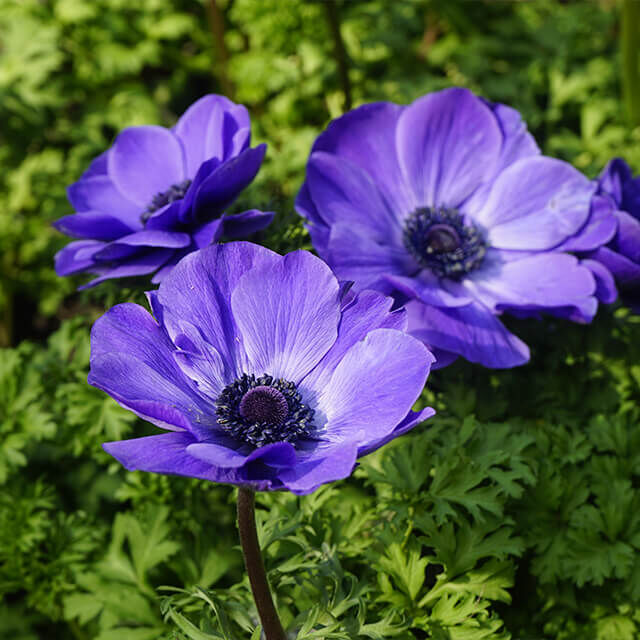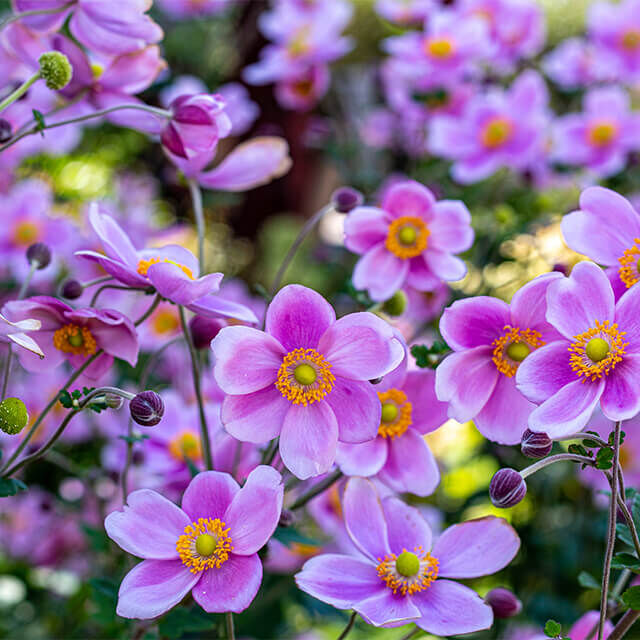Anemone: Origin and Care Tips

The anemone is a fascinating perennial that blooms either in spring, summer or autumn, depending on the species. Their growth height varies from small woodland flowers to imposing bedding plants. Particularly exciting: the delicate flowers of this ornamental plant react to even the slightest breeze - hence its name ‘anemone’.
Origin and species diversity
The plant genus Anemone belongs to the buttercup family (Ranunculaceae) and is mainly native to the Mediterranean countries and Western Asia. There are over 120 species, which are divided into different groups. The crown anemone and the autumn anemones are particularly well known.
What types of anemones are there?
Appearance and flowering time
Growth habit
Autumn anemones grow upright as perennial herbaceous plants with woody, short tubers. They grow to a height of 30 to 120 cm. Crown anemones grow 25 to 30 cm high.
Leaves
The leaves of anemones are tripartite, pinnate and slightly to heavily hairy.
Flowers
The flowers of autumn anemones are single or double, in white, pink, purple or red. The 4 to 6 mm long, thin stamens are striking. They flower from around July to October. The crown anemone, on the other hand, enchants with large, bowl-shaped flowers that appear in vibrant colours such as red, blue, purple or white.
Crown anemones flower from March to May.
Autumn anemones flower from July to October.
Anemones in the garden flower for between four and six weeks, depending on the species. Crown anemones add colour to the bed from March to May, while autumn anemones provide long-lasting blooms from July to October. An ideal location with sufficient sunlight and well-drained soil can also extend the flowering period.
Anemones are generally hardy. Autumn anemones, i.e. the perennials among the anemones, should be somewhat protected after planting in their first few winters, for example with foliage. Care should be taken with crown anemones, the spring-flowering plants with a tuber. If you do not live in mild climates, it is better to keep their tubers frost-free over winter.
Anemones are perennial. There are two main types: crown anemones, which flower in spring and grow from a tuber, and autumn anemones, which are classified as perennials.
Care tips for anemones - How do you look after anemones?
Anemones prefer a semi-shady to sunny location with well-drained, humus-rich soil. They thrive particularly well under shrubs or in naturalised beds. Waterlogging should be avoided at all costs.
- Like many spring-flowering bulbs and tubers, crown anemones require little care. Care should be taken to ensure that there is no waterlogging so that the bulbs do not rot. If the stems are harvested as cut flowers, they should be kept in a little water. Avoid combining them with daffodils in a vase.
- Autumn anemones are hardy perennials if they are placed in the right, wind-protected, semi-shady spot. Their soil - well-drained and rich in nutrients - should not dry out and waterlogging should also be avoided. The garden soil should be as well-drained, humus-rich and nutrient-rich as possible.
Anemones feel at home in light shade. They also grow in slightly sunnier locations. However, if it is too dark, fewer flowers will develop. Anemones should therefore not be chosen for underplanting. Varieties with white flowers are particularly sensitive. A spot where intensive rain and strong winds can be avoided will reward the anemone with a beautiful profusion of flowers.
The best time to plant anemones is actually spring. However, they can also be successfully planted in the ground until late summer, around August.
Before planting, the tubers should soak in a water bath for a day. Then place them as deep in the soil as they were previously in their pot. Root pieces should be planted about five centimetres deep. Don't forget to water after planting. Anemones look particularly beautiful when arranged in groups of three to five plants.
The stems of the anemones should be cut with a sharp, clean knife with a smooth cut. Tearing or an unclean cut can have a negative effect on the durability of the flower.
Anemones are extremely versatile and can be used in a variety of ways. In the garden, they provide colourful accents as bright spring or autumn bloomers, especially when planted in groups. They harmonise perfectly with other perennials and are ideal for near-natural beds or as underplanting for shrubs.
Anemones show off their full beauty in pots on balconies and terraces. Crown anemones in particular are suitable for cultivation in pots and provide a fresh splash of colour outdoors from March to May.
Anemones are also popular as cut flowers. They add an elegant, natural touch to bouquets and keep for up to ten days in a vase. To keep the flowers fresh for a long time, they should be watered regularly and not combined with daffodils.
Whether in the garden, on the balcony or as a stylish decoration indoors, anemones are a wonderful choice for any flower lover.
Pruning after flowering is particularly important if uncontrolled self-seeding is to be avoided. However, autumn anemones do not tend to self-seed. Their flower stems are cut back close to the ground to encourage them to sprout again. However, this should not be done too early, as the plant can still draw nutrients from the leaves. Only when the leaves and stems have completely dried out should the plant be cut back - in the following spring at the latest.
- Tuberous anemones can be propagated by sowing. This is best done in February in a cold box or greenhouse. Alternatively, the tubers can be dug up and divided during the dormant period.
- Autumn anemones can be propagated by seed or root cuttings. For this purpose, stolons can be cut off in spring and replanted elsewhere.
Anemones in the vase
Anemones keep for around eight to ten days as cut flowers. They should be placed in a small amount of water and not combined with daffodils, as the latter secrete a secretion that shortens the shelf life of other flowers.
Diseases and pests
Anemones are relatively robust, but can occasionally be attacked by aphids, mildew or snails. Feeding marks between the leaf veins can indicate an infestation by nematodes.
Whether as a bright spring messenger or as a delicate autumn flower - anemones are an enrichment for every garden. With the right care and the right location, they delight year after year with their impressive flowering splendour.















